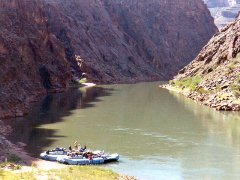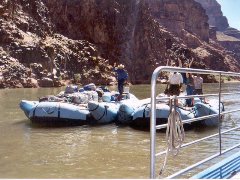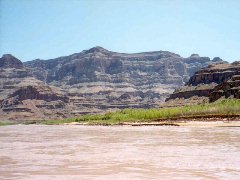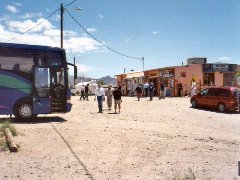
| Wes Boyd's Spearfish Lake Tales Contemporary Mainstream Books and Serials Online |

Separation Canyon, Lake Mead, Las Vegas

| Wes Boyd's Spearfish Lake Tales Contemporary Mainstream Books and Serials Online |

For the last time, I woke up to the sound of the burners, so got around and finished packing gear in the morning half light. Sadly, I crossed a significant divide back to the real world by pulling on my watch for the first time in a week and stuffing my wallet in a pocket before rolling up the Paco pad and packing it up with the sleeping bag. Finally, I hauled my gear down to the beach by the rafts, and hung around until breakfast was called -- French toast and link sausage.
It was still early, and we didn't have far to go and plenty of time before we were to be picked up by the jet boat at 10, so we stood around and talked about one thing and another. As we talked, the Grand Canyon Expeditions party passed us for the last time. Finally, we loaded the rafts and got under way.
It seemed strange out on the river that morning; no rapids lay ahead, and our life jackets, which we’d worn faithfully for a week, were now all stuffed into a big mesh bag laying loosely on the beaver board of one of the rafts. While the Canyon walls still stood high overhead, the river flowed smoothly, with none of the boils and eddies that had marked it upstream; no more rapids were to come, only memories of where there had once been rapids.
We didn’t float far, only a mile or so to Separation Canyon, where Separation Rapids once stood, the site of one of the more dramatic pieces of Canyon History. In the warm, clear air of the morning we piled off the rafts and onto the beach for one last time, and Joe led a hike a short distance up a talus slope to where a plaque commemorating the incident was bolted to the rock.
 |
|
Looking down at the Separation Canyon landing from the Memorial Plaque. |
When Major John Wesley Powell left Green River, Wyoming, back in 1869, he had four boats and ten men to head off into the unknown mysteries of the Green and Colorado Rivers. It wasn’t easy, Joe told us; the men had little whitewater skill -- virtually no one alive did, back then, and they had oak rowboats, not huge rubber rafts with motors. No one knew what would happen, what they would see. It was tough; they lost a boat early on, lost much of their gear, lost much of their food and what little was left was partly spoiled, even by the time they got to the Grand Canyon proper. Up till then, they’d portaged the worst rapids, or let the boats down them slowly on ropes, but by the time they got to Upper Granite Gorge, with it’s unportagable rapids, they’d learned a lot about how to handle the boats in heavy water, and they ran a lot of them -- but it was still hard, and dangerous, and as they got further down the river, no one knew what else lay ahead. The rapids were heavy and dangerous in Lower Granite Gorge, and by the time they reached Separation Rapids, three of the men had enough. The dangers, the difficulty, the near starvation had gotten to them, and the wide, gentle sidecanyon leading off to the north offered a potential escape route. The three decided to leave the river, and strike out for the rim, far above, and possible safety. Powell, who was rather authoritarian as a leader, tried to talk them out of it, to little avail. He knew from sextant readings and the barometers that they carried that they were getting fairly close to the Virgin River and the known country around its mouth. He tried hard to talk the three out of their journey. When that failed, he left the three a boat, with some rations sitting on it, and the remaining seven struck out down Separation Rapids -- which had to have been a pretty bad one, back before Lake Mead put it sixty feet below the water. Two days later, after one more blinger of a now-vanished rapid, Lava Cliff, and a couple of smaller ones, they floated out between the Grand Wash Cliffs and into the benign river that once flowed there, and soon after were in what passed for known territory. The three men who left the expedition were never heard from again; allegedly, they were killed by Indians, although there is some controversy about what really happened. No one knows for sure.
What must the spirits of those three thought to see us standing there, having come there in our big motor powered rafts, casually hiking up to the plaque after a week on the river, with little danger, little difficulty, plenty of food, lots of good times behind us? Had we been able to step back in time and tell them to hang in there, the story might have had a different ending . . . but then, there would be no plaque there, no name of “Separation.” We slowly climbed down the talus slope, and for the last time clambered aboard the big blue rafts. Each morning as we had started, Joe had given us an inspirational reading, to give us some thoughts for the day. Sometimes, these had been poetry, sometimes other writings, occasionally from his own journal, written late at night in the light of a flashlight after the dinner dishes had been done and the camp had gone to bed. Today, in this spot, for the first time he read from Powell, and nothing could have been more appropriate: "Now the danger is over, now the toil has ceased, now the gloom has disappeared, now the firmament is bounded only by the horizon, and what a vast expanse of constellations can be seen! The river rolls by us in silent majesty, the quiet of the camp is sweet; our joy is ectasy. We sit till long after midnight, talking of the Grand Canyon, talking of home."
 |
|
Goodbye to our friends, and the rafts that had carried us from Lee's Ferry. |
Once again, for the last time, the motors were fired up, and the rafts wiggled off of the sand of the banks. Once we got out on the river, Joe came up alongside Josh’s raft, and straps were put across to tie the two together, and side by side we ran down the river, both motors running, but only one being steered. In a sense, Separation Canyon was separation for us, as well, and we knew it. We only floated along like that for a few minutes in the glow of a successful trip and in the sadness that we would soon be parting from the six crewmen that had become such stalwart compatriots -- but in a few minutes, the white of a boat roaring up the river proved that it would be true. The “jet boat” -- a jet drive, diesel-powered barge with seating open to the sky soon roared into sight, spun around and came alongside. Joe and the guy running the boat exchanged a few words, and a duffle line developed to pass our personal gear across onto the big steel boat; we worked our way across and found seats, far from filling it. Then, the driver fired up the diesel, and we turn to look at our six friends, all standing on the rafts, waving good-bye to us as we waved good-bye to them.
They still had some trip remaining. We knew that they would soon be finding some quiet beach somewhere, to deflate and roll up the side tubes of the rafts, since they’re faster without them and the extra buoyancy they provide was no longer needed with the passengers and their gear now unloaded. Like us, they’d run the sixty miles to South Cove on Lake Mead, but at a much lower speed, then spend the late afternoon and evening derigging the rafts. Once again, they’d sleep out under the stars that night, there at the South Cove Marina. At six the next morning they’d be met by a semi to carry them and the rafts back to the warehouse in Flagstaff, where they’d spend the rest of the day Sunday cleaning stuff up and getting ready for the next trip. Josh and Joe would have the night off, we knew, but the next morning they’d be loading food and gear onto the rafts, getting ready to leave at noon for Lee’s Ferry, where they’d rig the rafts and get ready for the next group, at Tuesday noon -- and how we wished we could be with them, setting off down through the Canyon again, on yet another adventure! After that trip, they’d have a few days off; Joe would have a chance to get reacquainted with his fiance, while Josh planned on taking off to the Los Angeles area to get in some surfing. Parker, we knew, wouldn’t be running again until May 31, so she planned on spending some time with Lance in Colorado and Phoenix, but then she’d be doing four trips back to back, so it might be a while before she saw him again.
But that was not to be our adventure, our future, as the jet boat quickly built to speed. It was sixty miles down to South Cove, taking about an hour and a half, and considering a couple of brief stops we must have been running close to fifty miles an hour as we blasted down what remained of the Canyon, over rapids that had challenged Powell and Stanton and the other early river runners, but now buried deeply below the waters of Lake Mead. Familiar looking slopes and sedimentary layers and vegetation quickly swept by us, not at the gentle speed that we had become used to, but at blazing speed. The wind whipped across the open deck so hard it was hard to breathe, and how grateful I was that I’d thought to wear my windbreaking rain jacket on this warm, sunny and clear day, the kind of weather I had pretty much expected, but that we had seen little of. We roared downriver, sometimes using the whole river to make a turn, the steeply banked sides of the jet boat only a few feet from the shore, past canyon walls and sidecanyons and talus slopes covered with Sonoran vegetation.
As we proceeded downriver, the “bathtub ring” of Lake Mead got wider. There was still obviously some current in the water, but the white line above the water surface showed where in years past the water had washed off the desert varnish of the rocks, revealing their true buff color. As we proceeded down, the Canyon widened out. At a couple places on the south side, we could see places where helicopter tours flew people down to the riverside for quickie tours, lunch, and a ride on pontoon rafts like those so familiar from Michigan lakes, and we met a couple of them.
Not far before the Canyon came to an end, the jet boat driver stopped for a minute, partly to give us a breather from the blasting wind, and partly to give us a little local color. To the north, on river right, high up on a cliff, there was a nondescript opening to a cave, with the latticework of a steel tower standing nearby. This, he informed us, was an old bat guano mine. First discovered around the turn of the last century, in World War I, it had been determined that the guano deposits were sixty feet deep in spots, and went as far as a mile and a half back into the earth, which adds up to a lot of bat feces over a lot of years. The nitrates in the guano was nearly priceless in making smokeless gunpowder, so a mine was opened, with the guano being carried down the now benign river in barges, where it could be shipped off by train to munitions factories. When World War I ended, the mine closed, but it opened again in World War II, the guano again being shipped out by barge. By now, however, Lake Mead was there, and one of the purposes of Lake Mead was to supply water to Los Angles. Lake Mead can get nasty when the wind get up, we were told, and one day a storm sank a couple of barges. To have a couple of bargeloads of bat guano dumped into their drinking water supply did not make the Los Angeles officials very happy, to say the least, and after an exchange of fire by attorneys, another method of getting the stuff out had to be found.
As it worked out, there was a fairly large, flat area below the mine, and with some effort a small airstrip was opened up. For a while, small lightplanes ferried guano from the airstrip to another one on the south rim, a couple hundred pounds at a time, an endless repeating chain. This wasn’t the best answer, although it worked for a while, so a couple of towers were built, one on the north rim by the mine, one high on a mountain on the south rim, and a cable with a couple of buckets was strung between them. This got the mine through World War II. After the war, the mine closed again, and by now, there were better and cheaper methods of reducing nitrates, anyway, so it never reopened. Some time along in the fifties, some young stud in a jet fighter out of Nellis Air Force Base was hotdogging down the Canyon, and took about the top six inches of his tail off on the cable strung across the river. He got the fighter back to the base all right, and not much was said about it, until a few years later, when a Hollywood crew wanted to use the cable system to make a movie. The owners got them in touch with the old operator of the cable system, who now lived in Kingman, and he came up to get things going again, and discovered a weak spot in the cable, where the fighter had hit it. It was now too unsafe to use for anything, and eventually the cable was cut down. But, the mine owners investigated the problem with the cable, soon found out about how the cable had been damaged, and got a big settlement out of the US Air Force, proving that you can sometimes make money mining guano after all.
Not far below the guano mine, the horizon widened -- and it was now horizon, not Canyon rim. To either side, the walls went back and got lower. We were at the Grand Wash Cliffs, the end of the Canyon, that I’d seen from the jetliner more than a week before. There was no denying it -- the wonderful week in the scenic wonderland was over, and it was behind us. Ahead lay only low, nearly barren brown hills, with some barren brown mountains off in the distance. The shore was now a wide flatland of silt deposited by the river when Lake Mead was higher; the banks were high, but eaten away by the river, once again picking up the silt it had carried in its waters years before, carrying in a brown flood down lower into the huge artificial lake. Here, a little to my surprise, there was one last rapid, nothing big, but a river-wide white froth where the river tumbled down over some hard spot, probably a sand bar. The jet boat didn’t even slow, but did get over to one side of the river, and we crossed it with barely a thump on the planing hull -- no spray flew up, no raft bucked.
 |
|
The Grand Wash Cliffs -- and goodbye to the Grand Canyon. |
We twisted this way and that, and after a few more turns, the cold, now brown water of the Colorado River turned to the green waters of Lake Mead as the colder waters dove below the warm waters of the lake. Now, there were runabouts and jetskis; along the barren, sandy shores, we could see people pulled up to swim. On one beach, on the back side of a point, we could see a campsite with a handful of rafts pulled up on it -- obviously a private party that had also done the river, but were going the distance to South Cove, and stretching it out for a final day before they had to take out for real. Then, we swept around a point, and South Cove Marina stood before us. We could see a dock, and a big tour bus standing on the pavement. In a few minutes, the driver pulled the jet boat into the dock, and there was thankful quiet, and relief from the wind blast that had thundered at us for the last sixty miles. With no prompting, one last time, out of habit, we formed a duffle line to pass our bags off the boat, where they were spread out on the dock. One by one, we grabbed our bags and hauled them up to the bus.
Normally, buses aren’t allowed to cross Hoover Dam, due to security concerns, but the special permit that the bus company had allowed the crossing if all baggage was sitting out in plain sight in the seats, for whatever reason, rather than being stuffed in the bus’s baggage compartment. So we carried our bags onto the bus, and settled down into seats, feeling a little strange at having a solid roof over our heads after a week without. Soon, we were all aboard, and the bus driver started down the road, running through the nearly barren desert. A few miles out, as we climbed high above the shores of the lake and where we could look back and see its blue in the distance, we began to go through a forest of Joshua trees. There’s not much you can call a Joshua tree besides “weird” -- they have thick, scaly trunks, with balls of flat, spikelike leaves on their few branches. There were thousands of them out there, but as we ran south, the Joshua trees began to be filled with development lots of those five-acre “ranches” that seemed to infest the area like a colony of termites. There were small houses, usually scrappy, although occasionally there would be a nice one, and lots of mobile homes.
 |
|
Dolan Springs -- civilization? |
After a while, the driver pulled the bus into Dolan Springs, where there was a small country store, covered with cowboy and western memorabilia, and most people piled off the bus to get things to eat and drink, the first place you could buy something in over a week.
Soon we were back out on the road, and not much farther to the dullness of US-93, which I’d been over on my screaming trip to the south rim eight days before. Someone had picked up a Las Vegas newspaper in Dolan Springs, and I glanced at the front section. Not much new, here; same old, same old. It was as if nothing much had happened, and I reflected that I was just as glad that I hadn’t known about it. I remembered Joe telling the story of how he left on a trip on September 10, 2001, and didn’t hear about September 11 until September 15. Not this time; even the world as we knew it could have ended while we were gone and we wouldn’t have known about it.
We stopped south of Hoover Dam for a security check, then drove down to an overlook at the dam. Several of us piled off the bus for a quick photo session. From the overlook, we could see how wide the bathtub ring really was, nearly sixty feet -- the lake is down that much. We drove over the dam, and on the far side, through the bus window, I shot my last photos of the trip. All good things must come to an end, and this one was ending.
All too soon, we were heading through the ugly, dusty suburbs of Las Vegas, on the way to the airport. All too soon, we were there, and when the bus got to the departure area, I got off, along with three others -- the rest would go on to the Hawthorne Suites to disperse. ”Bye, everybody,” I said as I got up. “It’s been real. Maybe again, sometime.”
One of the things that had bothered me, right from the beginning, was that I knew I was going to be getting into Las Vegas about three, but that my plane wouldn’t leave until about 11. That meant eight rather dull hours that would have to be killed, in a town that’s not tuned to doing things that I like to do to kill time. But, now, I did get a little lucky. Looking for a place to kill a few hours, I wandered into a restaurant that wasn’t busy, and asked the waitress if there was a place back in the corner where I could sit by myself for a while, and if there was a place where I could sneak a smoke. She had both of them, a table back in the corner overlooking the airport ramp. I sat there for several hours, going through a hamburger and a couple of huge but very cold beers (remembering to not drink the water), working on my notes -- I was a day behind -- and shooting the bull with the waitresses. There were several of them on duty, and for several evening hours I was the only customer in the place. What I had anticipated to be a dreary time turned out to be a lot of fun.
It was well after dark when I left the restaurant and went down to the gate, still scribbling with writer’s cramp in an aching hand on my yellow waterproof note pad. I got into a discussion with a couple of guys that had been in Lost Wages for a trade show, for car wash chemicals, of all things, and finally the clock crawled around to where I could get on the airplane.
I walked down the aisle of the plane, and settled into my seat. I was still getting organized when a rather well-dressed young man and, I presume, his wife, sat down next to me. “We stayed at the MGM Grand on the Strip,” he said rather snottily, I thought, by way of introduction. “Where did you stay?”
I smiled and replied nonchalantly, “Oh, various sand bars at the bottom of the Grand Canyon.”




